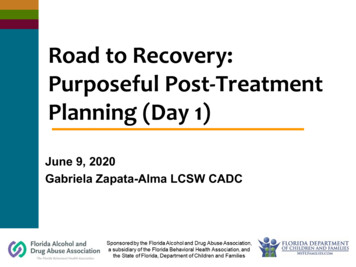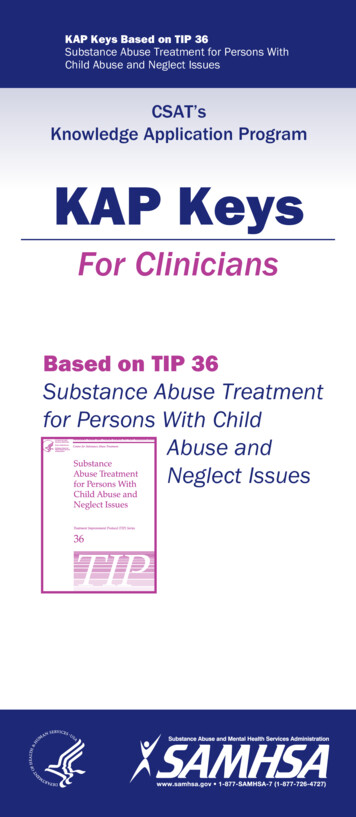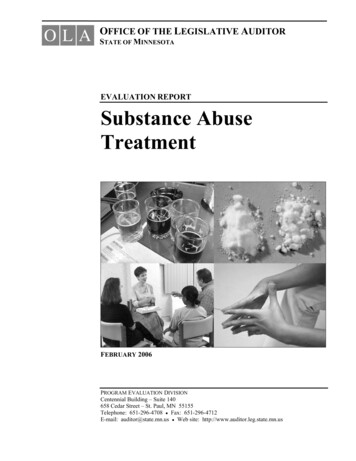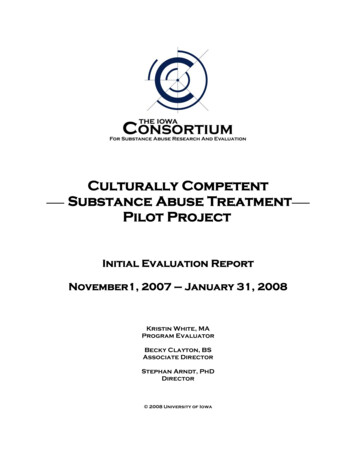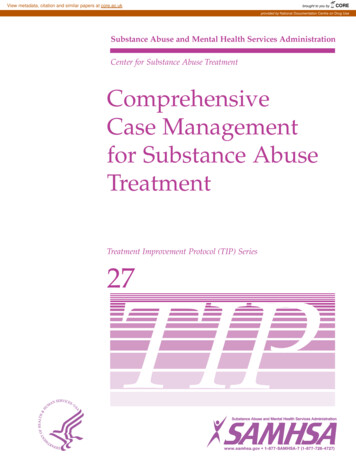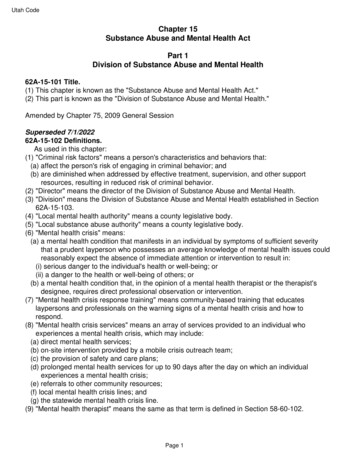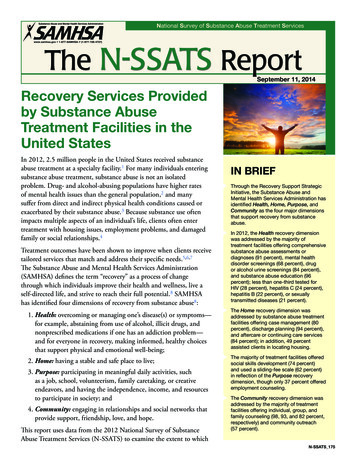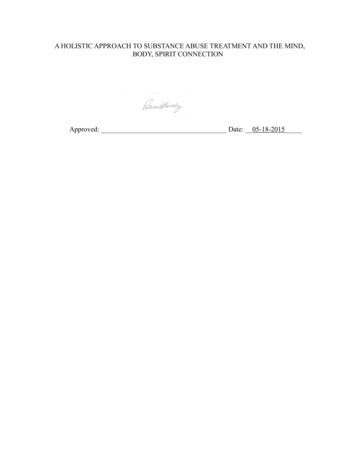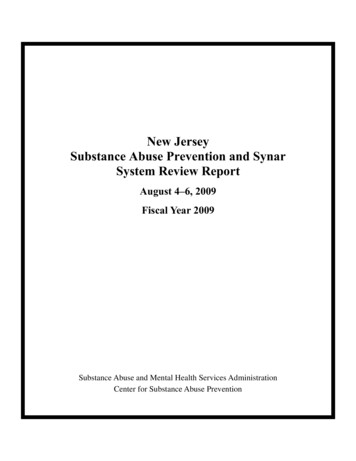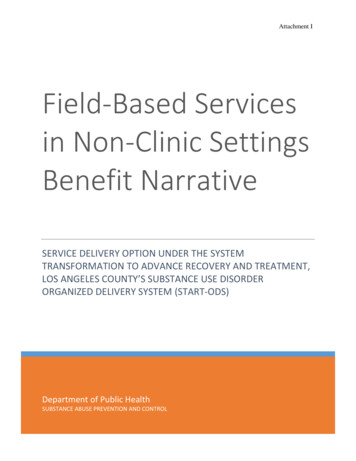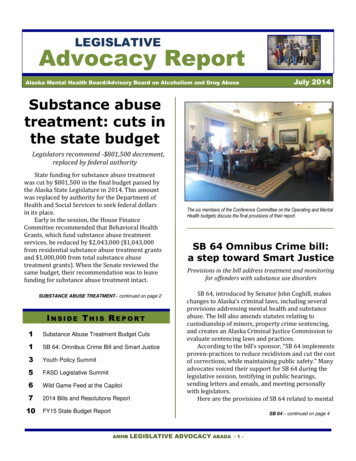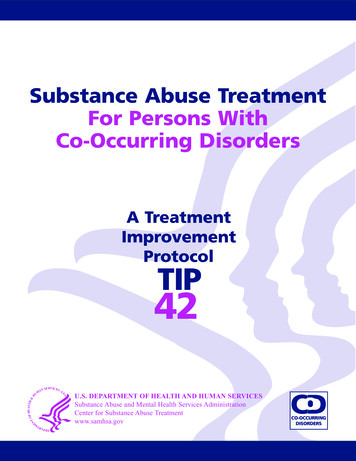
Transcription
Substance Abuse TreatmentFor Persons WithCo-Occurring DisordersA TreatmentImprovementProtocolTIP42U.S. DEPARTMENT OF HEALTH AND HUMAN SERVICESSubstance Abuse and Mental Health Services AdministrationCenter for Substance Abuse Treatmentwww.samhsa.govCO-OCCURRINGDISORDERS
Substance Abuse Treatmentfor Persons WithCo-Occurring DisordersStanley Sacks, Ph.D.Consensus Panel ChairRichard K. Ries, M.D.Consensus Panel Co-ChairA TreatmentImprovementProtocolTIP42U.S. DEPARTMENT OF HEALTH AND HUMAN SERVICESPublic Health ServiceSubstance Abuse and Mental Health Services AdministrationCenter for Substance Abuse Treatment1 Choke Cherry RoadRockville, MD 20857
AcknowledgmentsNumerous people contributed to the development of this TIP (see pp. xi, xiii, and appendices L, M, and N). This publication was produced by The CDM Group, Inc. under theKnowledge Application Program (KAP) contract, number 270-99-7072 with the SubstanceAbuse and Mental Health ServicesAdministration (SAMHSA), U.S. Departmentof Health and Human Services (DHHS). KarlD. White, Ed.D., and Andrea Kopstein,Ph.D., M.P.H., served as the Center forSubstance Abuse Treatment (CSAT)Government Project Officers. ChristinaCurrier served as the CSAT TIPs Task Leader.Rose M. Urban, M.S.W., J.D., LCSW, CCAC,CSAC, served as the CDM KAP ExecutiveDeputy Project Director. Elizabeth Marshserved as the CDM KAP Deputy ProjectDirector. Shel Weinberg, Ph.D., served as theCDM KAP Senior Research/AppliedPsychologist. Other KAP personnel includedRaquel Witkin, M.S., Deputy ProjectManager; Susan Kimner, Managing Editor;Deborah Steinbach, Senior Editor/Writer; andErica Flick, Editorial Assistant. In addition,Sandra Clunies, M.S., I.C.A.D.C., served asContent Advisor. Special thanks go to SusanHills, Ph.D., for serving as Co-Editor on thisTIP, and Doug Ziedonis, M.D., for his contribution to chapter 8. Jonathan Max Gilbert,M.A., Margaret K. Hamer, M.P.A., RandiHenderson, B.A., Susan Hills, Ph.D., andDavid Shapiro, M.S., M.Ed., were writers.Appendix K was prepared by MargaretBrooks, J.D., and SAMHSA staff in consultation with the Office of the General Counsel, theU.S. Department of Health and HumanServices, Washington, D.C.DisclaimerThe opinions expressed herein are the views ofthe Consensus Panel members and do not necessarily reflect the official position of CSAT,SAMHSA, or DHHS. No official support of orendorsement by CSAT, SAMHSA, or DHHSfor these opinions or for particular instruments, software, or resources described in thisiidocument are intended or should be inferred.The guidelines in this document should not beconsidered substitutes for individualized clientcare and treatment decisions.Public Domain NoticeAll materials appearing in this volume exceptthose taken directly from copyrighted sourcesare in the public domain and may be reproduced or copied without permission fromSAMHSA/CSAT or the authors. Do not reproduce or distribute this publication for a feewithout specific, written authorization fromSAMHSA’s Office of Communications.Electronic Access and Copiesof PublicationCopies may be obtained free of charge fromSAMHSA’s National Clearinghouse for Alcoholand Drug Information (NCADI), (800) 7296686 or (301) 468-2600; TDD (for hearingimpaired), (800) 487-4889, or electronicallythrough the following Internet World WideWeb site: www.ncadi.samhsa.gov.Recommended CitationCenter for Substance Abuse Treatment.Substance Abuse Treatment for Persons WithCo-Occurring Disorders. TreatmentImprovement Protocol (TIP) Series 42. DHHSPublication No. (SMA) 05-3992. Rockville,MD: Substance Abuse and Mental HealthServices Administration, 2005.Originating OfficePractice Improvement Branch, Division ofServices Improvement, Center for SubstanceAbuse Treatment, Substance Abuse and MentalHealth Services Administration, 1 ChokeCherry Road, Rockville, MD 20857.DHHS Publication No. (SMA) 05-3992Printed 2005Acknowledgments
ContentsWhat Is a TIP? .ixConsensus Panel.xiKAP Expert Panel and Federal Government Participants .xiiiForeword .xvExecutive Summary.xviiChapter 1—Introduction .1Overview.1The Evolving Field of Co-Occurring Disorders .2Important Developments That Led to This TIP .4Organization of This TIP.16Chapter 2—Definitions, Terms, and Classification Systems for Co-Occurring Disorders .21Overview .21Terms Related to Substance Use Disorders.22Terms Related to Mental Disorders .23Terms Related to Clients.26Terms Related to Treatment .27Terms Related to Programs .32Terms Related to Systems .33Chapter 3—Keys to Successful Programming .37Overview .37Guiding Principles .38Delivery of Services.41Improving Substance Abuse Treatment Systems and Programs .48Workforce Development and Staff Support .55Chaper 4—Assessment .65Overview .65Screening and Basic Assessment for COD .66The Assessment Process .71Chaper 5—Strategies for Working With Clients With Co-Occurring Disorders.101Overview.101Guidelines for a Successful Therapeutic Relationship With a Client Who Has COD .102Techniques for Working With Clients With COD .112Chapter 6—Traditional Settings and Models .137Overview.137Essential Programming for Clients With COD .138Outpatient Substance Abuse Treatment Programs for Clients With COD .143Residential Substance Abuse Treatment Programs for Clients With COD .161iii
Chapter 7—Special Settings and Specific Populations .183Overview.183Acute Care and Other Medical Settings.184Dual Recovery Mutual Self-Help Programs.190Specific Populations.197Chapter 8—A Brief Overview of Specific Mental Disorders and Cross-Cutting Issues .213Overview.213Cross-Cutting Issues.214Personality Disorders.220Mood Disorders and Anxiety Disorders.226Schizophrenia and Other Psychotic Disorders .231Attention-Deficit/Hyperactivity Disorder (AD/HD) .235Posttraumatic Stress Disorder (PTSD) .238Eating Disorders .240Pathological Gambling.246Conclusion.248Chapter 9—Substance-Induced Disorders .249Overview.249Description .249Diagnostic Considerations .252Case Studies: Identifying Disorders .253Appendix A—Bibliography .255Appendix B—Acronyms.309Appendix C—Glossary of Terms.313Appendix D—Specific Mental Disorders: Additional Guidance for the Counselor .325Overview.325Suicidality .326Nicotine Dependence.333Personality Disorders (Overview) .348Borderline Personality Disorder .353Antisocial Personality Disorder .359Mood and Anxiety Disorders .369Schizophrenia and Other Psychotic Disorders .385Attention Deficit-Hyperactivity Disorder (AD/HD) .402Posttraumatic Stress Disorder .408Eating Disorders .417Pathological Gambling.425Appendix E—Emerging Models .437Part I: Addresses for Models Referenced in the Text .437Part II: Other Emerging Models.439Programs .457ivContents
Appendix F—Common Medications for Disorders .459Pharmacologic Risk Factors.459A Stepwise Treatment Model .461Psychotherapeutic Medications 2004: What Every Counselor Should Know.463Appendix G—Screening and Assessment Instruments .487Addiction Severity Index (ASI) .487The Alcohol Use Disorders Identification Test (AUDIT).488Beck Depression Inventory-II (BDI-II) .488CAGE Questionnaire.489Circumstances, Motivation, and Readiness Scales (CMR Scales) .489Clinical Institute Withdrawal Assessment (CIWA-Ar) .490The Drug Abuse Screening Test (DAST).490Global Appraisal of Individual Needs (GAIN).491Level of Care Utilization System (LOCUS).491Michigan Alcoholism Screening Test (MAST).492M.I.N.I. Plus .492Psychiatric Research Interview for Substance and Mental Disorders (PRISM) .493Readiness to Change Questionnaire .493Recovery Attitude and Treatment Evaluator (RAATE) .494Structured Clinical Interview for DSM-IV Disorders (SCID-IV).494Substance Abuse Treatment Scale (SATS) .495University of Rhode Island Change Assessment (URICA) .495Appendix H—Sample Screening Instruments .497Mental Health Screening Form-III.498Simple Screening Instrument for Substance Abuse .499Appendix I—Selected Sources of Training .513Sources of Training on Addiction Disorders .513Sources of Training on Mental Health .515Sources of Training on Co-Occurring Disorders .515Listservs and Discussion Groups on Co-Occurring Disorders .516Appendix J—Dual Recovery Mutual Self-Help Programs andOther Resources for Consumers and Providers.519Dual Recovery 12-Step Fellowships.519Supported Mutual Help for Dual Recovery.520Other Resources for Consumers and Providers.521Appendix K—Confidentiality .523Federal Laws and the Right to Confidentiality .523Appendix L—Resource Panel .527Appendix M—Cultural Competency and Diversity Network Participants .531Appendix N—Field Reviewers.533Index .539CSAT TIPs and Publications.559Contentsv
15D-16viPersons With Alcohol, Drug Abuse, or Mental Disorder in the Past Year .5Rates of Antisocial Personality, Depression, and Anxiety Disorder by Drug Dependency .8Substance Abuse Treatment Facilities Offering Special Programs for Clients With COD .11Level of Care Quadrants.29Six Guiding Principles in Treating Clients With COD.38Levels of Program Capacity in Co-Occurring Disorders.44A Vision of Fully Integrated Treatment for COD.45The Co-Occurring Collaborative of Southern Maine .49Assessing the Agency’s Potential To Serve Clients With COD .51Financing a Comprehensive System of Care for People With COD .52Essential Attitudes and Values for Clinicians Who Work With Clients Who Have COD .57Examples of Basic Competencies Needed for Treatment of Persons With COD .58Six Areas of Intermediate-Level Competencies Needed for the Treatmentof Persons With COD .59Examples of Advanced Competencies in the Treatment of Clients With COD .60Treatment Planning and Documentation Issues for Mental and Substance Use Disorders.61Certification in Health Professions .63Reducing Staff Turnover in Programs for Clients With COD .64Assessment Considerations .74Sample Treatment Plan for George T. (Case 2) .96Considerations in Treatment Matching .97Stages of Change .116Motivational Enhancement Approaches .117A Four-Session Motivation-Based Intervention .119Checklist for Designing CM Programs.123Engagement Interventions .165Principles of Implementation .166Sample Training and Technical Assistance Curriculum .167Residential Interventions.172TC Modifications for Persons With COD.174Criteria for Major Depressive Episode.206Key Questions in a Suicide Risk Review .330DSM-IV Criteria for Nicotine Withdrawal .341The Fagerstrom Test for Nicotine Dependence.342Brief Strategies for Smoking Cessation.344Brief Strategies 2. Components of Presriptive Relapse Prevention.348Characteristics of People With Antisocial and Borderline Personality Disorders .350Step Work Handout for Clients With BPD.360Counseling Tips for Clients With APD .367Antisocial Thinking-Error Work .368Drugs That Precipitate or Mimic Mood Disorders.373Engaging the Client With Chronic Psychosis .391Biopsychosocial Assessment of High-Risk Conditions .392AD/HD Symptom Cluster: Inattention .403AD/HD Symptom Cluster: Hyperactivity-Impulsivity .403Grounding: A Coping Skill for Clients With Emotional Pain .413How Are Eating Disorders and Substance Use Disorders Related?.421Contents
D-17 General and Specific Screening Questions for Persons With Possible Eating Disorders .422D-18 Diagnostic Criteria for Pathological Gambling Compared to SubstanceDependence Criteria.426D-19 Comparison of Action and Escape Pathological Gamblers .427H-1 Sources for Items Included in the Simple Screening Instrument for Substance Abuse .503H-2 Simple Screening Instrument for Substance Abuse Interview Form.506H-3 Simple Screening Instrument for Substance Abuse Self-Administered Form.509H-4 Scoring for the Simple Screening Instrument for Substance Abuse .511Advice to the Counselor BoxesChapter 2Antisocial Personality Disorders.24Psychotic Disorders.25Mood and Anxiety Disorders .25Chapter 4Do’s and Don’ts of Assessment for COD .67Chapter 5Forming a Therapeutic Alliance .103Maintaining a Recovery Perspective.105Managing Countertransference .106Monitoring Psychiatric Symptoms .107Using Culturally Appropriate Methods .111Using Contingency Management Techniques.125Using Relapse Prevention Methods .130Chapter 6Recommendations for Providing Essential Services for People With COD .141Treatment Principles From ACT .157Treatment Principles From ICM .159Recommended Treatment and Services From the MTC Model .175Chapter 7Working With Homeless Clients With COD .200Providing Community Supervision for Offenders With COD .202Treatment Principles and Services for Women With COD .210Chapter 8Counseling a Client Who Is Suicidal.215Counseling a Client With Borderline Personality Disorder .222Counseling a Client With an Anxiety or Mood Disorder .229Counseling a Client With a Psychotic Disorder .234Counseling a Client Who Has AD/HD .237Counseling a Client With PTSD .241Counseling a Client With an Eating Disorder.245Counseling a Client With Pathological Gambling Disorder .248Contentsvii
What Is a TIP?Treatment Improvement Protocols (TIPs), developed by the Center forSubstance Abuse Treatment (CSAT), part of the Substance Abuse andMental Health Services Administration (SAMHSA) within the U.S.Department of Health and Human Services (DHHS), are best-practiceguidelines for the treatment of substance use disorders. CSAT draws onthe experience and knowledge of clinical, research, and administrativeexperts to produce the TIPs, which are distributed to a growing numberof facilities and individuals across the country. The audience for theTIPs is expanding beyond public and private treatment facilities as alcohol and other drug disorders are increasingly recognized as a majorproblem.CSAT’s Knowledge Application Program (KAP) Expert Panel, a distinguished group of experts on substance use disorders and professionals insuch related fields as primary care, mental health, and social services,works with the State Alcohol and Drug Abuse Directors to generate topics for the TIPs. Topics are based on the field’s current needs for information and guidance.After selecting a topic, CSAT invites staff from pertinent Federal agencies and national organizations to a Resource Panel that recommendsspecific areas of focus as well as resources that should be considered indeveloping the content for the TIP. Then recommendations are communicated to a Consensus Panel composed of experts on the topic who havebeen nominated by their peers. This Panel participates in a series of discussions; the information and recommendations on which they reachconsensus form the foundation of the TIP. The members of eachConsensus Panel represent substance abuse treatment programs, hospitals, community health centers, counseling programs, criminal justiceand child welfare agencies, and private practitioners. A Panel Chair (orCo-Chairs) ensures that the guidelines mirror the results of the group’scollaboration.A large and diverse group of experts closely reviews the draft document.Once the changes recommended by these field reviewers have beenincorporated, the TIP is prepared for publication, in print and online.ix
The TIPs can be accessed via the Internet atthe URL: www.kap.samhsa.gov. The move toelectronic media also means that the TIPs canbe updated more easily so that they continue toprovide the field with state-of-the-art information.While each TIP strives to include an evidencebase for the practices it recommends, CSATrecognizes that the field of substance abusetreatment is evolving, and research frequentlylags behind the innovations pioneered in thefield. A major goal of each TIP is to convey“front-line” information quickly but responsibly. For this reason, recommendations proffered in the TIP are attributed to eitherPanelists’ clinical experience or the literature.If research supports a particular approach,citations are provided.Other Drug Abuse. The revised TIP providesinformation about new developments in therapidly growing field of co-occurring substanceuse and mental disorders and captures thestate-of-the-art in the treatment of people withco-occurring disorders. The TIP focuses onwhat the substance abuse t
A Treatment Improvement Protocol Substance Abuse Treatment For Persons With Co-Occurring Disorders TIP 42 CO-OCCURRING DISORDERS U.S. DEPARTMENT OF HEALTH AND HUMAN SERVICES
